Aleksandra Kawałko1, Bartosz Rigall2, *Lidia Zawadzka-Głos2
The use of impedance audiometry in the diagnosis of children in the 6-month period in the Department of Pediatric Otolaryngology of the Medical University of Warsaw
Wykorzystanie audiometrii impedancyjnej w diagnostyce dzieci w okresie 6 miesięcy przebywających w Klinice Otolaryngologii Dziecięcej WUM
1Student Audiological and Phoniatric Scientific Group in Medical University, Warsaw, Poland
2Department of Pediatric Otolaryngology, Medical University of Warsaw, Poland
Head of Department: Associate Professor Lidia Zawadzka-Głos, MD, PhD
Streszczenie
Wstęp. Audiometria impedancyjna to jedno z najlepszych dostępnych obiektywnych badań oceniających funkcję ucha środkowego. Może być wykonane u pacjentów w każdym wieku. Na podstawie wyników audiometrii impedancyjnej można wysnuć pierwsze wnioski dotyczące stanu ucha środkowego i dalszej diagnostyki.
Cel pracy. Celem pracy była retrospektywna ocena wyników audiometrii impedancyjnej przeprowadzanej w okresie 6 miesięcy u dzieci przebywających w Klinice Otolaryngologii Dziecięcej WUM w Warszawie.
Materiał i metody. W okresie od maja do końca listopada 2021 roku w Klinice Otolaryngologii Dziecięcej Warszawskiego Uniwersytetu Medycznego wykonano audiometrię impedancyjną 319 dzieciom z wykorzystaniem sprzętu firmy Interacoustics Titan. Analizie poddano uzyskany wynik krzywej tympanometrycznej według Jergera u każdego pacjenta oraz wieku, w jakim pacjent był badany.
Dyskusja. Najczęstszym typem tympanogramu był typ A (norma). Najmniejszą ilość wyników uzyskaliśmy przy typie Ad. Odnotowaliśmy zwiększoną częstość patologii po stronie lewej.
Wyniki. Analiza wyników potwierdziła istotną rolę audiometrii impedancyjnej w badaniach słuchu. Szeroka diagnostyka audiologiczna pozwala zminimalizować ryzyko popełnienia błędów, niepotrzebnych hospitalizacji i zbędnego angażowania bloku operacyjnego.
Summary
Introduction. Impedance audiometry is one of the best objective tests available to assess the function of the middle ear. It can be performed in patients of any age. Based on the results of impedance audiometry, you can draw the first conclusions about the condition of the middle ear and further diagnostics.
Aim. The aim of the study was a retrospective assessment of the results of impedance audiometry carried out over a period of 6 months among children staying in the Department of Pediatric Otolaryngology of the Pediatric Clinical Hospital in Warsaw.
Material and methods. In the period from May to the end of November 2021, in the Department of Pediatric Otolaryngology of the Pediatric Clinical Hospital of the Medical University of Warsaw, impedance audiometry was carried out on 319 children using Interacoustics Titan equipment. The results were analyzed for each patient and the age at which the patient was examined.
Results. The most common type of tympanogram was type A (norm). The smallest number of results was obtained with the Ad type. We noted an increased number of pathology on the left side.
Conclusions. Analysis of the results confirmed the important role of impedance audiometry in hearing tests. Extensive audiological diagnostics allow to minimize the risk of making mistakes, unnecessary hospitalizations, as well as unnecessary involvement of the operating theatre.
Introduction
Impedance audiometry is the most widely used objective, non-invasive examination of the function of the middle ear. This test is used in audiological diagnosis from newborns to the elderly. Simplicity, short execution time and automation are the decisive features, which prove the superiority of AI over other hearing tests.
The whole examination consists of two parts: tympanometry and measurement of the stapedius muscle reflex. The impedance audiometry has the greatest value when its components are interpreted together. This allows to fully visualize the clinical condition of the patient.
The impedance in tympanometry describes the sum of the resistances in the path of sound from the external environment to the inner ear. The individual elements of the human ear, their mass and elasticity affect the impedance value. They are components of the chain through which the acoustic wave passes. The mass in this system is mainly made by the auditory ossicles with the eardrum. The connections between all of the elements, as well as the mobility of the stapes footplate, determine the resilience (1).
Impedance audiometry testing is mainly used in:
– diagnostics of otosclerosis, otitis media with effusion, extracochlear hearing disorders,
– assessing the function of the auditory trumpet,
– topodiagnosis of facial nerve palsies,
– to assess the presence of a loudness compensation symptom (2-4).
It should be borne in mind, that the examination will be objective only, if the continuity of the eardrum is preserved and the lumen of the external auditory canal is completely sealed by the probe. The lack of tightness makes it difficult to take a correct measurement, because the air flows out through the existing gap.
The main recording of impedance audiometry is the tympanometry curve. During the examination, pressure is artificially induced in the external auditory canal causing the eardrum to deflect. The peak of the tympanogram shows the pressure, at which the eardrum has the highest compliance. The shape of the result allows you to direct the diagnosis by carrying a lot of valuable information. It should be noted, that a normal result does not exclude the existence of pathology (1, 5, 6).
There are five types of tympanometric curves (A, B, C, As, Ad) according to Jerger (fig. 1-5).
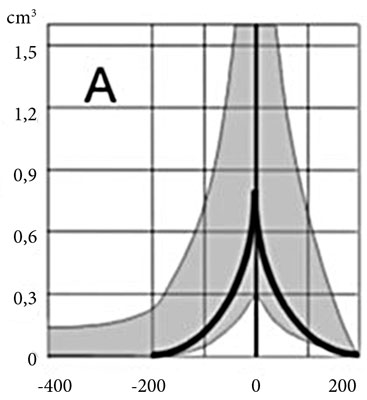
Fig. 1. Curve A (5)
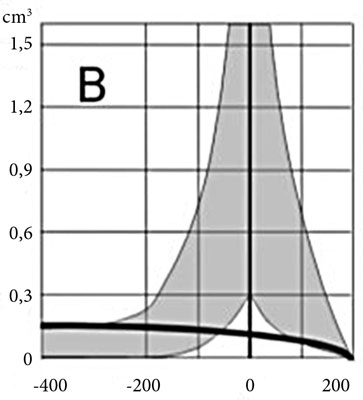
Fig. 2. Curve B (5)
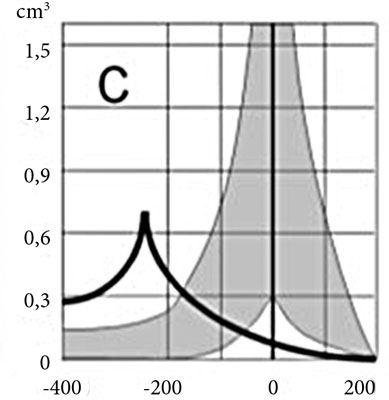
Fig. 3. Curve C (5)
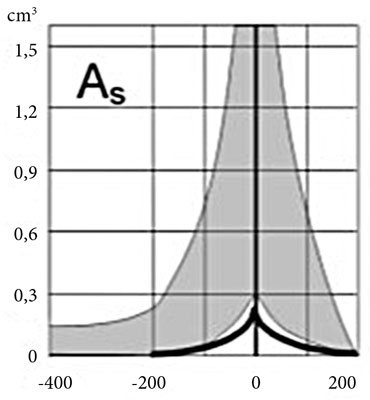
Fig. 4. Curve As
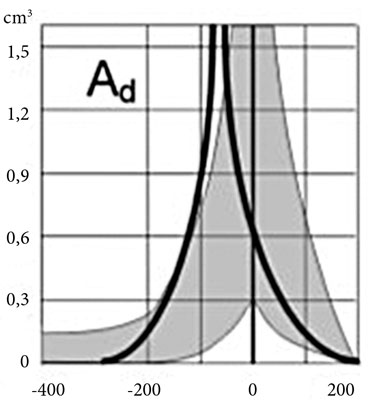
Fig. 5. Curve Ad (5)
Curve A is the correct result.
Curve B raises doubts with its low amplitude and lack of peak. We encounter such a curve, for example, in exudative otitis media, adhesion otitis media, perforation or presence of ventilation tubes in the tympanic membrane, and external auditory canal obstruction as well as the presence of fluid behind the eardrum (7, 8).
Curve C is characterized by a leftward shift of the peak. This indicates an obstruction or dysfunction of the auditory trumpet, retraction of the eardrum, hypertrophy of the 3rd tonsil, or upper respiratory tract infections and allergic rhinitis.
Curve As is slightly flattened. This result may be within the correct range in infants. If the patient is older, diagnosis for otosclerosis, cholesteatoma or exudative otitis should be performed.
Curve Ad is characterized by an extremely high amplitude with an indeterminate peak. This raises suspicion of a rupture of the ossicular chain, flaccidity of the eardrum or both. If the patient is a newborn then the result should be considered as a normal.
The stapedius muscle reflex is triggered by the administration of a strong auditory stimulus. It is bilateral, meaning that when one ear is stimulated, the reflex appears on both sides. Recording of the reflex threshold can be done ipsi- and contralaterally. The contralateral method is more accurate and preferred for diagnosis as an indicator of conductive hearing loss. Analysis of obtained results is very useful in differential diagnosis and topodiagnosis of auditory nerve palsy (9-11).
Aim
The aim of the study was a retrospective assessment of the results of impedance audiometry carried out over a period of 6 months among children staying in the Department of Pediatric Otolaryngology of the Pediatric Clinical Hospital in Warsaw.
Material and methods
Between May and the end of November 2021, impedance audiometry was performed on 319 children in the Department of Pediatric Otolaryngology in the Pediatric Clinical Hospital of the Medical University of Warsaw. Patients were from the otolaryngology ward as well as patients from other wards within the hospital. The tests were performed in the hearing test laboratory with the use of Interacoustics Titan equipment (fig. 6).
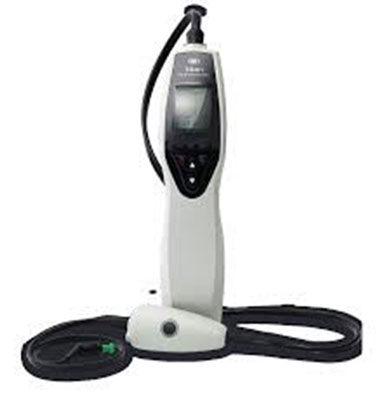
Fig. 6. Titan by Interacoustics
In each patient tympanometry was performed with ipsilateral recording of stapedius muscle reflex with the tone of 226 Hz. Stapedius muscle reflex was tested with the following frequencies: 500, 1000 and 2000 Hz and intensity of 80, 85, 90, 95 and 100 dB. The results were analyzed for each patient and the age at which the patient was examined (12).
Results
After analyzing all of the patients, the distribution of tympanometric curves is as follows in table 1.
Tab. 1. Summary of tympanograms from May to November 2021 (own elaboration)
| Type A | Type B | Type C | Type As | Type Ad |
| Right ear | Left ear | Right ear | Left ear | Right ear | Left ear | Right ear | Left ear | Right ear | Left ear |
| 178 | 195 | 112 | 125 | 102 | 106 | 49 | 42 | 4 | 2 |
Table 1 illustrates that the most common type of tympanogram is type A (normal). It is most common on the left side. The least frequent curve type in patients of our Clinic is Ad. It should be noted that the second most common type according to Jeger is type B, which indicates quite frequent presence of complications of acute otitis media. During this period (6 months) we noted an increased frequency of pathology on the left side in patients examined in our department.
Figure 7 shows the interdependence of the percentages of the different types of tympanograms obtained in the conducted studies.
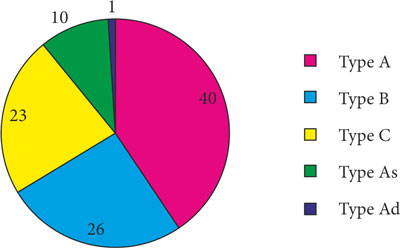
Fig. 7. Percentage distribution of tympanogram types in patients examined in the Clinic from May to November 2021 (own elaboration)
In figure 8 it is clear, that the largest group of patients are children between the ages of 4 and 6 years. Another large group are patients in the age range of 0 to 3 years. The other groups represent a smaller proportion with the smallest range between 16 and 18 years.
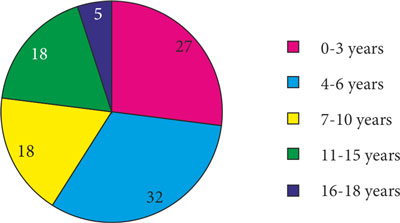
Fig. 8. Percentage age distribution of patients examined in the Clinic from May to November 2021
Discussion
The results of tympanometry presented above confirm the important and very significant role of impedance audiometry in the diagnosis of various types of ear disorders. Comprehensive audiological diagnostics minimizes the risk of mistakes, unnecessary hospitalizations as well as unnecessary involvement of the operating theatre. It is our recommendation, that every patient presenting for ear surgery has a current impedance audiometry test or other current objective and subjective hearing tests. We believe that such action will allow us to quickly and effectively cure the patient from the ailment with which he reported to the department. It is also important to check during the follow-up examinations whether the treatment has brought the expected result.
In patients with healed exudative otitis media, we observed that eardrum compliance increased in all study groups; however, the greatest increase was seen in patients after drain placement. This suggests that treatment by drain placement accelerates the increase in middle ear susceptibility values (13).
Conclusions
Analysis of the results confirmed the important role of impedance audiometry in hearing tests. Extensive audiological diagnostics allow to minimize the risk of making mistakes, unnecessary hospitalizations, as well as unnecessary involvement of the operating theatre.
Piśmiennictwo
1. Śliwińska-Kowalska M: Audiologia kliniczna. Mediton, Łódź 2005: 137-148.
2. Northern J, Downs M: Hearing in Children. 5th ed. Williams and Wilkins Co., Baltimore 2002.
3. Konopska L: Otologicze i audiologiczne uwarunkowania dobrostanu dzieci z desonoryzacją. Instytut Pedagogiki, Katedra Pedagogiki Specjalnej, Uniwersytet Szczeciński 2018: 177-192.
4. Pruszewicz A, Obrębowski A: Audiometria impedancyjna. [W:] Pruszewicz A (red.): Zarys audiologii klinicznej. Wydawnictwo Akademii Medycznej, Poznań 2003; 4: 269-281.
5. Hojan E: Protetyka słuchu. Wydawnictwo Naukowe UAM, Poznań 2017: 212-220.
6. Kowalska S, Konopka W, Słomińska R, Olszewski J: Wpływ doświadczenia w rozpoznawaniu uszkodzeń słuchu za pomocą audiometrii impedancyjnej. Otolaryngol Pol 2008; LXII (6): 764-768.
7. Niemczyk K: Wykłady z otolaryngologii. Medipage, Warszawa 2012: 159-167.
8. Niemczyk K, Jurkiewicz D, Składzienia J et al.: Otolaryngologia kliniczna. Medipage, Warszawa 2014: 49.
9. Kochanek K, Sobieszczańska-Radoszewska Ł, Skarżyński H: Zasady i metody diagnozowania narządu słuchu u dzieci. Audiofonologia 2000; XVII: 91-103.
10. Sobieszczańska-Radoszewska Ł, Siedlecka H, Bralczyk T: Orientacyjne badania słuchu u noworodków. Ped Pol 1992; 7-8: 407-409.
11. Pruszewicz A: Metody badania w wieku rozwojowym. [W:] idem, Zarys audiologii klinicznej. Wydawnictwo Akademii Medycznej, Poznań 2003: 282-287.
12. Skarżyński H, Mueller-Malesińska M, Wojnarowska W: Klasyfikacja zaburzeń słuchu. Audiofologia 1997; X: 49-60.
13. Hassmann-Poznańska E, Goździewski A, Piszcz M et al.: Wpływ zmian strukturalnych błony bębenkowej na wyniki audiometrii impedancyjnej i tonalnej w rozszerzonym zakresie częstotliwości. Otolaryngol Pol 2010; 64(5): 307-312.







